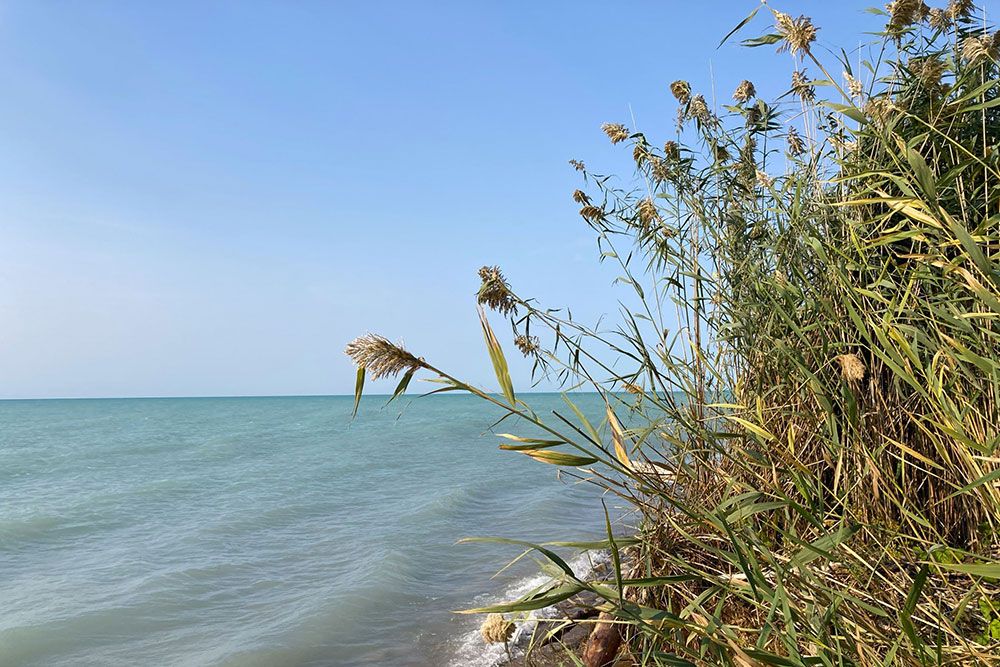Managing Canada's 'worst invasive plant'

New funding helps in Huron County to manage invasive Phragmites, Canada’s ‘worst invasive plant’
Ontario Phragmites Action program’s Invasive Phragmites Control Fund provides 2025 funding for 87 projects to manage threat posed by invasive plant; ABCA is funding recipient for Phragmites initiative in Huron County
Ausable Bayfield Conservation Authority (ABCA) has been helping landowners and communities for more than a decade to manage Canada’s “ ... worst invasive plant,” Phragmites australis (European Common Reed). Phragmites is a tall reed that takes over wetlands and out-competes native plants.
The Ontario Phragmites Action (OPA) program has announced they are supporting 87 new invasive Phragmites management projects in 2025 through the Invasive Phragmites Control Fund. This funding is made possible thanks to an investment from the Ontario Ministry of Natural Resources and coordinated by the Invasive Species Centre and Nature Conservancy of Canada. ABCA is one of the funding recipients.
In 2025, ABCA is expanding regional Phragmites management across Huron County by engaging at least 15 partners, including municipalities, landowners, conservation organizations, and volunteer groups. Their project aims to control Phragmites on more than 1,700 kilometres (km) of roads, map an additional 1,200 km to prepare for future management, and target 12 new sites for treatment. A new Invasive Species Management category in the County of Huron’s Huron Clean Water Project (HCWP) will provide cost-share funding to increase participation and improve coordination. With support from the Invasive Phragmites Control Fund, this project will scale up efforts, reach under-engaged areas, and strengthen long-term invasive species control throughout the county.
Mike Harris is Ontario’s Minister of Natural Resources. “By investing in the management of invasive Phragmites, our government is taking decisive action to protect Ontario’s wetlands, roadways, and community spaces,” he said. “With more than 80 projects underway across the province, we’re strengthening communities, preventing costly future impacts, and preserving our rich biodiversity.”
Nathan Schoelier is ABCA Stewardship, Land and Education Manager. “We are very appreciative of the new Invasive Phragmites Control Fund support to help us build upon our efforts to manage this threat in Huron County and local municipalities,” he said. The County of Huron is a local leader in management of Phragmites, he said.
There is support for private landowners in Huron County to manage Phragmites. If you would like to manage invasive Phragmites on your property, contact ABCA at 519-235-2610 or toll-free 1-888-286-2610 or email stewardship staff at abca.ca through the staff contacts web page.
Phragmites is an aggressive, perennial, towering grass that can grow taller than the tallest of humans. It spreads rapidly through seeds and root fragments (rhizomes), which can be transported by wind, water, vehicles, heavy machinery, and human activity. Once established, Phragmites forms dense, monoculture stands that out-compete native vegetation, leading to reduced biodiversity.
OPA empowers municipalities, conservation authorities, Indigenous communities, and incorporated not-for-profit organizations to implement on-the-ground Phragmites control efforts. These initiatives contribute to a coordinated, province-wide program aimed at managing Phragmites across Ontario. This includes the project with ABCA.
“Addressing this invasive species proactively helps avoid substantial costs, including reduced agricultural yields, obstructed public access to waterways, increased flooding, higher roadside maintenance expenses, and lost tourism revenue,” said Colin Cassin, Invasive Species Centre Executive Director. “This project, as well as the other projects funded by the Invasive Phragmites Control Fund, are one of Ontario’s greatest assets in overcoming the challenges posed by Phragmites.”
“The Nature Conservancy of Canada is proud to collaborate with the Invasive Species Centre, local communities and partners to manage invasive Phragmites and restore resilient ecosystems that support people and economies,” said Brett Norman, Nature Conservancy of Canada’s Director of Habitat Restoration. “We’re excited to see continued growth of this coordinated effort, and grateful for the support from Ontario’s Ministry of Natural Resources to accelerate this important work across the province.”
OPA’s funding support in 2025 includes the following organizations: Ausable Bayfield Conservation Authority; Birds Canada; Caldwell First Nation; City of St. Thomas; County of Perth; County of Wellington; Eel?naapéewi Lahkéewiit (Delaware Nation); First Nations Phragmites Control; Grand River Employment and Training INC dba Kayanase; Haldimand Stewardship Council Inc.; Long Point Region Conservation Authority; and Norfolk County.
Since 2019, the Invasive Phragmites Control Fund has funded more than 131 projects that help protect natural spaces in Ontario from the impacts of Phragmites. To learn more about the Ontario Phragmites Action program and the Invasive Phragmites Control Fund, visit ontariophragmitesaction.ca